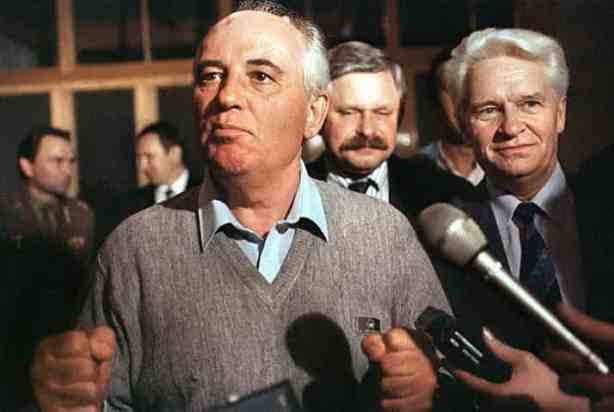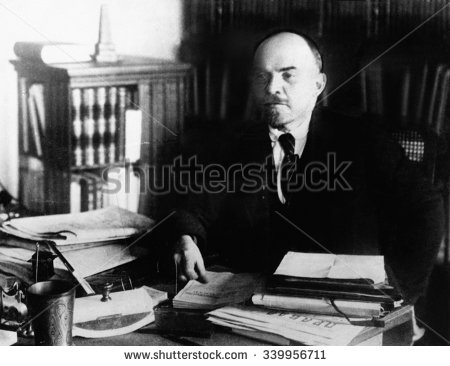The heuristic Soviet reform GT model
Let there be three players: Agent (1) is the reformer [RF], who stakes out a ‘centrist’ (in terms of the reform and the center-republic axes) programme because of the presence of agents (2) and (3). The second agent, Agent (2) is the conservative [CO] and the third player, Agent (3) is the would-be capitalist transformer/radical critic [CT]. Each of these three agents in the Soviet reform ‘game’ have distinct goal functions:
(5) RF : G (RF)

The reformer personified by Mikhail Gorbachev
(6) CO: G (CO)

The conservative personified by Yegor Ligachev
(7) CT: G (CT)

The radical/capitalist transformer personified by Boris Yeltsin (left, holding the paper in his hands
The goal functions of these three agents could be construed as maximization problems subject to constraints. For example, the reformist goal function, G (RF) could be written as the Ferrerite function:
(8) G (RF) = Max RF’ = Max (F, D, E)
= Min (UI, EW, SUS)
where RF’ is a row vector defined as:
(9) RF’ = [C1, S1, C2e, C3e, S2e, S3e, I, T, r]
where
C1 = a measure of comprehensiveness of the reform program[1] and 0 < C1 < 1
C2e = RF’s expectation of the extent of Agent (2), or CO’s conservative program
and 0 < C2e <1
C3e = RF’s expectation of the extent of Agent (3), or CT’s radical program
and 0 < C3e < 1
S2e = RF’s expectation of Agent (2), or CO’s political strategy
S3e = RF’s expectation of Agent (3), or CT’s political strategy
S1 = RF’s political strategy for reform
I = measure of supportiveness of international environment and 0 < I < 1
T = state of available theoretical guidance and ideological support
and r = residuals
In this case, maximizing RF’ means maximizing (C1, S1) subject to the {C2o, C3o, S2o, I, T, r} constraint where the C2o, C3o, S2o, and S3o are the actually observed values rather than RF’s expectations regarding the program and strategy of the two other players. This means that there are solution values C1* and S1* equivalent to:
(10) C1* = f(C2o, C3o, S2o, S3o, I, T, r)
(11) S1* = g(C2o, C3o, S2o, S3o, I, T, r)
One can surmise what C1; intuitive analysis would suggest that C1 for Khrushchev would be greater than that of Brezhnev while that of Gorbachev would be greater than both. Similarly, one can see that I for Gorbachev is greater than that of his predecessors. If one gives a numerical value to S1, then that of Gorbachev would be numerically greater than the corresponding value for Khrushchev. The same would be true for the T variable.
The goal functions of the two other agents could be cast similarly as constrained maximization problems. The contents of their goal functions will contain similar C2, C3, S2, and S3 factors. The same {I, T, r} constraint applies to all three agents. Part of the constraint for Agents (2) and (3) will be their opponents’ political program and strategy.
Even with distinct goal functions, one can conceive of all three agents participating in a political game of gathering the broadest support and amassing the maximum amount of resources and personnel to prevail and implement their respective programs. It seems realistic to assume, given the Soviet situation during the early and peak phases of the Gorbachev reform period that most likely not a single agent can win. In this case, two-person coalitions must and will be formed for a winning program to be adopted. Such a winning program will obviously be a compromise.
Should Agents (1) and (2) coalesce against Agent (3) and win, the solution values to the game will be represented by C1,2* and S1,2* equivalent to:
(12) C1,2* = h(C3o, S3o, I, T, r)
(13) S1,2* = i(C3o, S3o, I, T, r)
C1,2* could be construed as the political compromise forged between Agents (1) and (2) while S1,2* is their joint strategy versus Agent (3). The compromise between these two agents could be anywhere between scenarios II and II outlined below. Perhaps the reformer (RF) will get some leeway for the operation of market forces while the conservative gets assured that the constitutional guarantee for the communist party’s monopoly of power remains.[2]
We can likewise work out similarly-structured solution values for coalitions between Agents (1) and (3) and between Agents (2) and (3).
If, as had actually happened (after the defeat of the August 1991 coup), Agent (3) opposed a coalition of Agents (1) and (2) and won, the relevant solution values are represented as:
(14) C3* = j(C1,2o, S1,2o, I, T, r)
(15) S3* = k(C1,2o, S1,2o, I, T, r)
The games that these three agents played were asymmetric PDs. This point could be seen if we subdivide the over-all game into 2-person sub-games. In the contest between the reformer and the conservative, the reformer can only choose amongst the following options: compete, neutralize, compromise, or surrender. However, as economic reformer, he could not possibly cooperate with the conservative for whatever reason. As it turned out, he could do so but not as an economic reformer but as a Soviet national or citizen.
In contrast, aside from the above options, the conservative may cooperate with the reformer on the basis of altruism and/or an extended notion of rationality. The asymmetry can be seen also in their pay-offs. For the reformer, his positive and negative pay-off is quite discernible. From the conservative’s point of view, it is only his negative pay-off (in the event of the reformer’s triumph) that is clear. He loses power, perks and privileges. He is not sure what positive pay-offs are in store for him under a reformist regime. The positive pay-offs may only exist in the form of side-payments the reformist makes in his behalf to buy the conservative’s cooperation, or at least, his neutrality.
When I first wrote this essay in September 1991, before the demise of the Soviet state, I listed the following equilibrium solutions, or outcomes of these Soviet games below:
I. No or very cosmetic change (classic Stalinism): CO wins
II. Radical economic reform without democratization: RF and CO coalition wins
III. Democratization without significant economic reform: RF and CT coalition wins
IV. Democratization with substantial economic reform: RF and CT coalition wins
V. Transformation into capitalism (of the social democratic type?): CT wins
VI. Stalemate (this is an uneasy position and will not last)
During the last phases of the Gorbachev period, the Soviet game degenerated into a two-person non-cooperative zero-sum game between the conservatives and the radicals. The political centrist position became increasingly unviable and Gorbachev, erstwhile the consummate centrist, became more and more identified with conservatism (especially when the fate of the Soviet state hung on the balance) against the decentralizing and secessionist radicals. Gorbachev gave more weight to the goal of keeping the Soviet Union as a single state even at the expense of economic reform, violence, and deaths.
In the aftermath of the August 1991 coup initiated by the conservatives (obviously a betrayal of the Gorbachev-Ligachev coalition), the center-republican axis apparently emerged as the principal determinant of Soviet game outcomes. The possible ‘solutions’ along this line were: (a) continued existence of the old Soviet Union (already made moot by the independence of the Baltic states); (b) a new, looser union composed of the 12 remaining republics each of which would have greater autonomy in deciding internal political and economic mechanisms; and (c) break-up and the disappearance of the Soviet Union as a state. As it turned out, the Soviet Union indeed disappeared.
The Soviet Union’s demise suggests that the economic reform question is without a solution.[3] For this reason, the contest shifted dramatically and suddenly to the question of maintaining the Soviet Union as a unified federal state. Such a question was resolved in favor of the radicals and the Soviet state died as a result.
To be continued…
Next post: The political contenders in the Philippines and the games they play
Notes:
[1] Again, this reform program is comprehensive and incorporates proposals relating to the proper relationships between the federal center, Moscow, and the republics of the Soviet Union.
[2] Market liberalization does not require a liberal state, as evidenced by the Chinese political economy after Mao’s death in 1976.
[3] The argument for this conclusion is still being written.


















